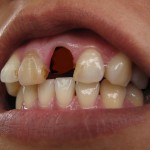
Tooth avulsion, the complete displacement of a tooth from its socket as a result of trauma (assault, fall, sports injury or traffic accident) is characterised by compromised neurovascular supply, pulp necrosis, and loss of periodontal ligament (PDL) cells. It is thought that immediate replantation offers the best chance of survival, but this is not always possible. Temporary storage in a suitable medium avoids drying out of the PDL cells improving chances of replantation. The ideal storage medium should have no or minimal microbial contamination, physiologically compatible pH and osmolality for maintaining PDL cell viability and be readily available. The patients own saliva has been recommended as a temporary option and a range of alternative options have been suggested including Hank’s balanced salt solution (HBSS), milk, propolis, egg white, coconut water, or Ricetral.
The aim of this review was to identify the effectiveness of any technique available to laypeople for storing an avulsed tooth compared with storage in milk or saliva.
Methods
Searches were conducted in the Medline/PubMed, Embase and Cochrane Library databases. Randomized controlled trials (RCTs), Non-randomized studies: non-randomized controlled trials, interrupted time series, controlled before-and-after studies, and cohort studies were considered. Two reviewers independently screened and selected studies and extracted with disagreements being resolved by a third reviewer. The Cochrane risk of bias tool was used to assess RCTs with the ROBINS-I tool being used for non-randomised and observational studies. Certainty of evidence was rates using the GRADE (Grading of Recommendations, Assessment, Development and Evaluation) approach. Risk ratios (RR) were used to assess dichotomous outcomes and mean differences (MD) or standardised mean differences (SMD) for continuous outcomes. Meta-analyses were conducted were feasible.
Results
- 33 studies (19 RCTs, 7 non-RCTs,7 prospective cohorts,) were included.
- In the RCTs, and non-RCTs teeth extracted for orthodontic reasons were used to simulate the storage of avulsed teeth prior to replantation.
- 17 studies compared storage in Hank’s balanced salt solution (HBSS) compared to milk.
- 12 studies reported on storage in water, 4 in coconut water, egg white or tap water 3 on storage in propolis solutions or the Dentosafe® box; and 2 on storage in aloe vera gel, probiotic media, or oral rehydration salts (ORS) compared with milk.
- Single studies assessed each of the following comparisons: storage in buttermilk, castor oil, cling film, epigallocatechin-3-gallate (EGCG), GC Tooth Mousse, rice water, saliva and thereafter HBSS, neem extract SOS, Zahnbox® or turmeric extract.
- Five studies evaluated the storage of avulsed or extracted teeth in saliva compared with storage in a Dentosafe® box, milk, another person’s saliva/mouth, or saline solutions.
- In 23 experimental studies the viability of the periodontal ligament (PDL)cells as a measure of tooth viability.
- Observational studies evaluated success clinically and radiographically.
- Meta-analysis (12 studies,22 comparisons, 412 teeth) showed that cell viability rates for teeth stored in HBSS for 5 minutes up to 24 hours were significantly higher than those stored in milk; SMD= 2.47 (95%CI; 1.59 – 3.34).
- Meta-analysis (2 RCTs, 5 estimates, 100 teeth) rate of the teeth stored in solutions made of ORS (including Ricetral) was found to be higher after 45 to 90 minutes of storage than those stored in milk; SMD= 4.16 (95%CI; 2.10 – 6.23).
- Meta-analysis (3 RCTs, 86 teeth) showed propolis solutions were more effective than milk for preserving PDL cell viability; SMD= 1.73 (95%CI; 1.12 – 2.33).
- One study suggest that extracted teeth wrapped in cling film show a high rate of cell growth.
- The cell viability rate was significantly lower in teeth stored in saline solutions tap water, buttermilk, castor oil, GC Tooth Mousse, and turmeric extract than those stored in milk
- The certainty of evidence was considered low to very low due to limitations in study design, indirect study populations and outcome measures, and imprecision.
Conclusions
The authors concluded: –
Although milk was shown to extend the periodontal ligament cell viability before replantation compared with saline or tap water, the following media have also demonstrated efficacy at preserving the cell viability: Hank’s balanced salt solution, propolis, oral rehydration salts, rice water, and cling film.
Comments
3 major databases were searched by the authors for this review although only those studies with English abstracts were considered. This may have resulted in some relevant studies being missed. Twenty-three (69%) of the included studies assessed the viability of the PDL cells under a microscope following storage of the teeth for between 15 minutes to 24 hours. While this was carried out in a similar manner across the included studies the findings are indirect and may not translate to the clinical environment. Although 1400 teeth were included in the review many of the solutions under test were only used on a small number of teeth. Three prospective cohort studies looked at the storage of 72 avulsed teeth on the success of replantation finding no difference between storage in saliva or milk; RR = 0.96 (95%CI; 0.65 -1.43). So while this review provides a good summary of the currently available information on this topic large well-designed prospective studies are needed to understand whether these findings translate to the clinical setting.
Links
Primary Paper
De Brier N, O D, Borra V, et al. Storage of an avulsed tooth prior to replantation: A systematic review and meta-analysis [published online ahead of print, 2020 Apr 28]. Dent Traumatol. 2020;10.1111/edt.12564. doi:10.1111/edt.12564
Other references
Dental Elf – 25th Mar 2019
Dental Elf – 24th Sep 2018
Root resorption: high incidence after replantation of avulsed teeth
